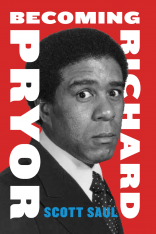About the Site
“Richard Pryor’s Peoria” aims to bring to life the first two decades of Richard Pryor’s life in Peoria, Illinois. Pryor’s childhood and adolescence were historically rich, and this website offers everyone a chance to explore firsthand the materials of that history, to feel the thrill of contact with the past.
Historians experience a “eureka” moment when, in poring through an archive, they discover a revelatory document. In researching my biography of Pryor, I experienced them aplenty — when I found an eighty-year-old news clipping that underscored the audacity of his grandmother, when I came upon a review of his first performance onstage, or when I read the sobering divorce papers of his parents and connected it to Peoria’s high rates of divorce. These documents — many of them ephemeral and fragmentary, and all of them generated out of a particular moment, place, and confluence of interests — were pulsing with life and meaning. I wanted others to feel that life, and find their own meanings.
The website is also an experiment in the digital humanities, an attempt to open up the work of a biography for the digital age. Traditionally, biographers have done their research — rooted around in archives, conducted their interviews, sleuthed for missing puzzle pieces — and then streamlined that research to write the story of the person in question. For the sake of their readers, they often bury some of the messiness of what their research has dug up. Biographies, like the lives they chronicle, tend to move in a straight line.
The web allows for us to create a more open-ended experience. On this site, you can transport yourself into different places within Peoria, or investigate the traces left by a particular individual, or use a particular subject as the vector of your exploration. Or you can follow the transformation of Peoria as a city over time. I know that different users will choose different pathways through the archive, and take pleasure in that fact.
* * *
A Note on Sources
Every archive is defined, in part, by its boundaries — by what it includes and what it does not. Here you’ll find a large selection of the written artifacts, or in some cases the visual artifacts, that I uncovered in my attempt to reconstruct the world of Richard Pryor’s childhood and adolescence. These were crucial to the research behind my biography of Pryor, but in order to provide a still fuller portrait of Pryor and his circles, I also needed to go beyond more conventional archival work and interview those who had known Pryor or could give insight into his life in some other fashion. Obviously, much of Pryor’s experience as a child and young man never made it into the Peoria Journal Star, the reports of the Carver Community Center, or the photographs his family kept, and so I had to consult the memories of those whose lives had intersected with his.
On my quest to understand Pryor from the inside out, I interviewed those who had shared a crib with him or lived in the North Washington Street district with him; those who had befriended him at school; those who had played gigs with him at Harold’s Club or Collins Corner; and so on. To compose my biography, that’s to say, I had to gather two forms of testimony: the testimony of the archive and the testimony of those who had lived alongside Pryor. Then I had to reconcile these two kinds of evidence, weighing them against each other when necessary, braiding them together when appropriate. I considered including the material from my Peoria-based interviews on this website in some form, but the technological and logistical difficulty of the task kept me from doing so.
Readers interested in a more multi-dimensional — and more intimate — account of Pryor’s years in Peoria are advised to delve into my book, which traces Pryor’s journey from Peoria all the way to Hollywood stardom.
— Scott Saul
* * *
Acknowledgements
“Richard Pryor’s Peoria” is the fruit of a collaboration between UC-Berkeley Professor Scott Saul, UC-Berkeley’s DLab, and Stanford University’s Spatial History Center. Both UC-Berkeley and Stanford have generously supported the building of the site.
The website would not exist, however, without the generosity of a great number of people, most of whom hail from the city of Peoria, Illinois.
Scott Saul wishes to acknowledge the contributions of the following individuals and institutions: Pam Adams, Linda Aylward, the Bahai Center of Peoria, Jimmy Binkley, the Bradley University Special Collections Library, Matthew Clark, Loren Cornish, Jane Fishbeck, Dick Green, Cecil Grubbs, Michael Grussemeyer, Martha Hammer, Edie Harris, Margaret Kelch, Norm Kelly, Tammy Lomelino, Joe Mosley, Sam Mosley, Harold Parker, Jr., the staff of the Peoria Public Library, the Peoria Journal Star, the Peoria County Circuit Clerk, Dylan Penningroth, Jim Ralph, Elaine Sokolowski, David Sprattling, John Stenson, Rosalyn Taylor, Fred Tieken, John and Cathryn Timmes, and Jon Wright.
He wishes especially to thank these members of the Pryor family, who have generously shared their memories and mementos: Barbara McGee, Elizabeth Pryor, Jennifer Pryor, Richard Pryor, Jr., and Sharon Wilson Pryor.
Editor and publisher: Scott Saul
Site designer: William Bottini
Site developers: Christopher Church, Scott Paul McGinnis, and Alex Tarr
Site writers: Camille Brown, Maya Kronfeld, Ismail Muhammad, and Alex Tarr
Cartographer-in-chief: Erik Steiner
Design guru: Ethan Goldstine
Questions or comments? Please write to Scott Saul at ssaul@berkeley.edu. He welcomes your feedback.
